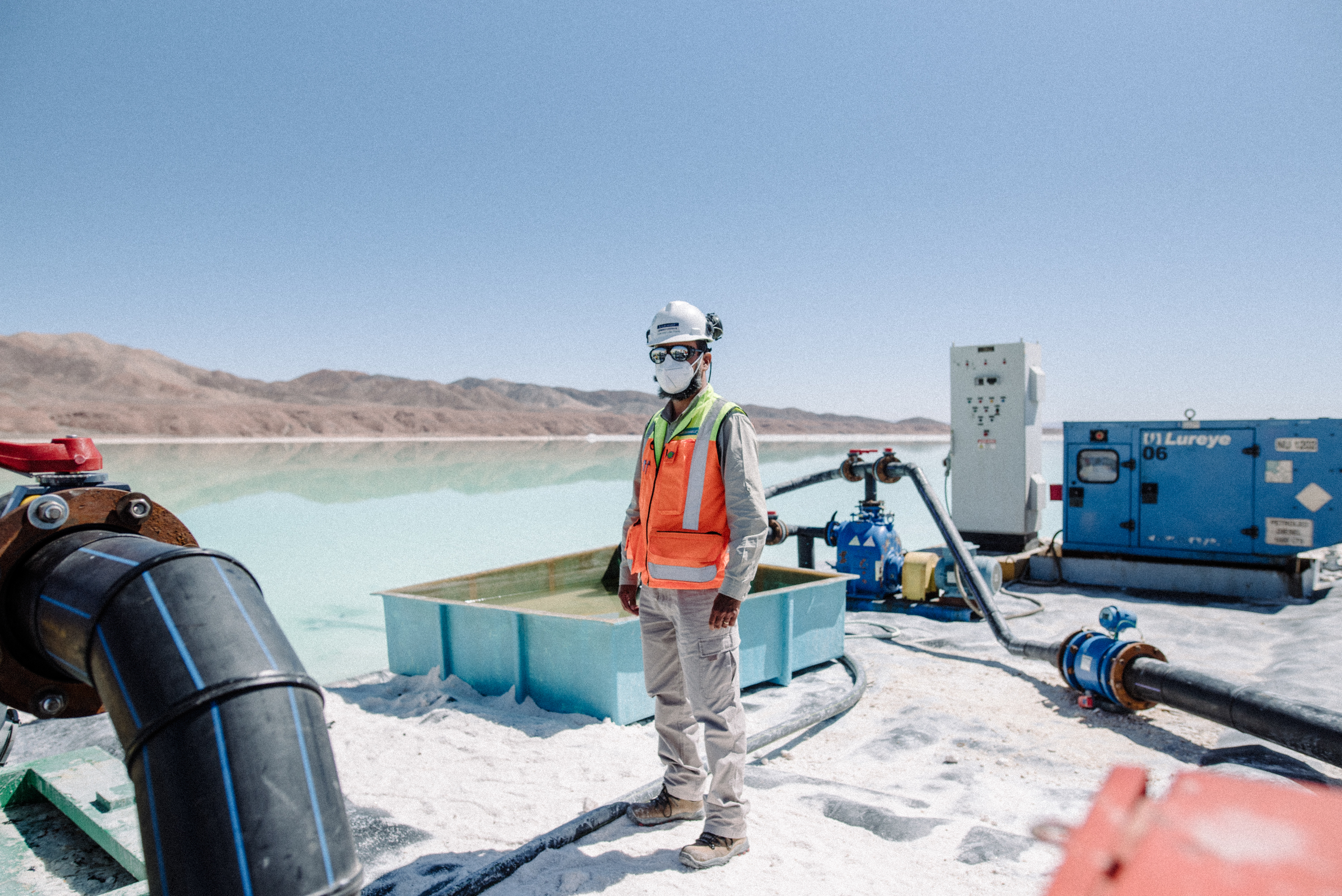
A worker performs maintenance on pipes used during brine extraction at a lithium mine in the Atacama Desert in Chile on Aug. 24.
Paz Olivares Droguett for NPR
In the middle of the desert in northern Chile, massive pools of Caribbean blue water sit next to what appear to be snowdrifts.
But this is a lithium mine.
The pools are filled with salty groundwater that contains lithium. It's a key component in the rechargeable lithium-ion batteries for electric cars, solar panels and other green technologies.
"It's really, really a beautiful place," says Marcelo Valdebenito, a public relations officer for Albemarle Corp., the Charlotte, N.C.-based chemical company that operates the mine. "This is the lithium that powers the world."
Indeed, the world is hungry for the silvery-white metal. The International Energy Agency is projecting a more than 40-fold increase in demand for lithium by 2040. Lithium prices have hit record highs this year.

Left: Lithium mines extract groundwater brine that is 10 times saltier than seawater. It is evaporated over 18 months into a 6% lithium solution. Center: Piles of salt, a byproduct of the evaporation process. Right: A sample of lithium concentrate ready to be transported to a plant for purification.
Paz Olivares Droguett for NPR
Despite growing concerns about the environmental impact of lithium extraction, skyrocketing demand is good news for mining companies in Chile. The South American country is the second-largest lithium producer after Australia. And Argentina, Bolivia and Chile are known as the "lithium triangle," together holding more than half of the world's proven lithium reserves.
Annual production at the Albemarle mine has increased from 22,000 tons to 84,000 tons since 2016, says Ignacio Mehech, the company's country manager in Chile.
"We are growing as the demand is growing and today we are a much bigger company," Mehech told NPR, adding that the company now has 1,000 employees in Chile, up from 250 five years ago.

Pools of groundwater brine that are in the final stage of evaporation at the Albemarle mine on Aug. 24.
Paz Olivares Droguett for NPR
South America could power up
Even so, the region's lithium output is just a fraction of what it could be, leading to fears of an eventual bottleneck in world supplies.
Bolivian President Luis Arce has pledged to make his country "the world capital of lithium" and supply 40% of global demand for the metal by 2030. But due to technological challenges and community resistance, as well as heavy state intervention in the economy, the industry has been slow to develop. Production in Bolivia remains negligible.
Economic turmoil has kept Argentina from opening more mines.
Meanwhile, Chile has high taxes and strict mining regulations, says Mehech. The red tape for production permits involves securing approval from the nation's nuclear energy commission since the metal can be used in nuclear power and weapons.
"It is very difficult and that's why you don't see more lithium companies in Chile," Mehech says of Albemarle, which he says is one of just two companies producing lithium in Chile.
Mining raises environmental concerns
But some Chileans prefer a go-slow approach.

Left: Workers monitor the 150 precipitation pools at the Albemarle mine. Center and right: Salt, a byproduct of the brine evaporation process, is piled up at the Albemarle lithium mine in the Atacama Desert on Aug. 24.
Paz Olivares Droguett for NPR
They include microbiologist Cristina Dorador, who has spent years studying the salt flats of the Atacama Desert. She says lithium mines extract huge amounts of groundwater. Ten-times saltier than seawater, this brine is then placed in enormous evaporation pools. After 18 months, the resulting 6% lithium solution is then turned into a white lithium powder and exported for use in batteries.
Dorador says removing so much groundwater will inevitably make the Atacama Desert — home to Chile's lithium mines — hotter and drier. She recently co-authored an investigation linking lithium mining to an 11% reduction in the local flamingo population over the past decade.
"With so much pressure from the world to produce more lithium," she says, "the price is going to be paid by Chile's environment."
Why not make the batteries, too?
Another critic is Andrés Díaz, who directs the Center for Energy and Sustainable Development at Diego Portales University in Santiago, the Chilean capital. Instead of just lithium, he thinks Chile should produce and export higher-valued lithium-ion batteries that the country currently imports from Asia at a steep cost.
To move in that direction, Albemarle signed an agreement with the Chilean government to spend $300 million on research and development here by 2043.
"For us, it doesn't make any sense to export lithium and then buy from other countries batteries with a material that we produced at the very beginning," Díaz says.

Evaporation pools at the Albemarle mine on Aug. 24.
Paz Olivares Droguett for NPR
Mehech acknowledges that lithium mining uses a lot of groundwater but claims the tradeoff is worth it. He points out that the amount of water required to produce enough lithium for an electric car battery is about the same amount needed to produce a half pound of beef or 11 avocados.
The avocados, he says, will last for just a few days, "but a lithium battery lasts for 10 years and then you can recycle it."
Copyright 2022 NPR. To see more, visit https://www.npr.org.

